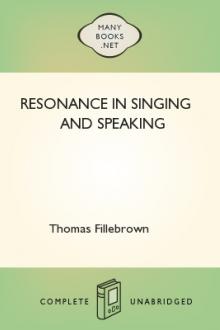Resonance in Singing and Speaking by Thomas Fillebrown (book suggestions .TXT) 📕

- Author: Thomas Fillebrown
- Performer: -
Book online «Resonance in Singing and Speaking by Thomas Fillebrown (book suggestions .TXT) 📕». Author Thomas Fillebrown
Sing the five vowel sounds throughout the scale as indicated. At first practise only on scales that are in easy range.
music
[Listen]
VIa
music
[Listen]
Exercise VII FOR PRODUCTION OF THE VOWEL SOUNDS IN PROPER FOCUS
Produce the hung at once, and add the vowel. Be sure that the vowel sound follows the same course as the "ng" sound which precedes it, and produces the same sensation in the nose.
The vowels are arranged in the order chosen because ee is the most easily focused while ah is by far the most difficult to focus, and hence the worst possible sound for initial practice. Think of the tone as being made in the nose and head.
Let there be no break or stopping of the tone when passing from the ng sound to the vowel. Simply change the tone into the vowel desired by the proper change in the articulating organs.
Sing the five vowel sounds connectedly, being sure that each vowel is correctly placed before passing to the next. The proper use of the lips will aid greatly in focusing the vowels. Start with the scale that is in comfortable range.
music
music
[Listen]
Exercise VIII TO ENLARGE THE THROAT AND FOCUS THE VOWELS
Open the mouth well and be sure that the vowel sounds are delivered as in the previous exercises; this will insure largeness with proper resonance.
When practising this exercise, be careful, as with the others, that each vowel sound in its order is correctly given before passing to the next. Only in this way can rapid progress be made.
The words bing, sing, ting, fling, swing are excellent to use for further practice.
music
music
[Listen]
Exercise IX QUICK CHANGING NOTES WITHOUT CHANGING RESONANCE
The important point in this flexible exercise is to keep the vowel-color, the focus or resonance, unchanged throughout the phrase. Begin quietly, give the ng freedom and the upper resonance will adjust itself. This phrase is longer than in previous exercises; be sure then that you still have breath at the end—breath enough to sing further. Sing quietly. Pitch the exercise to suit the voice.
music
[Listen]
Exercise X FOR AGILITY
Sing each vowel sound separately before passing to the next. Be sure to start each vowel sound in purity and maintain it without change. Pitch the exercise to suit the voice.
music
[Listen]
For variants on the above use as initial consonants b, p, m, f, v, d, k, n, t, and l.
Exercise XI TO DEVELOP THE USE OF THE LIPS AND UNDER JAWWhen practising this exercise protrude the lips and raise them toward the nose as far as possible; also make an effort to enlarge and widen the nostrils. This exercise may be practised more quickly than the preceding, but never at the expense of clearness of vowel distinction. Carry the exercise higher or lower, and in different keys, to suit individual voices. With a slight initial accent sing each two-measure section smoothly as one phrase. Avoid accenting each separate vowel sound. To do so would produce a series of jerks.
music
[Listen]
After practising the above as written modify it as follows:
1. Bee-boo-boh-baw-bah.
2. Pee-poo-poh-paw-pah.
3. Mee-moo-moh-maw-mah.
4. Fee-foo-foh-faw-fah.
5. Vee-voo-voh-vaw-vah.
6. Dee-doo-doh-daw-dah.
7. Kee-koo-koh-kaw-kah.
8. Nee-noo-noh-naw-nah.
9. Tee-too-toh-taw-tah.
10. Lee-loo-loh-law-lah.
Be careful not to blur the vowel sounds; each must be distinct and pure, and the change from one to the next must be made with a minimum of effort and without disturbing the focus of the tone.
music
[Listen]
The divisions (a and b) of each of the above four variants may be regarded as distinct exercises or not. For further practice use as initial consonants any or all of the following: b, p, m, f, v, d, k, n, t, and l.
Exercise XIII ASCENDING AND DESCENDING SCALEAs in the previous exercises practise quietly with unvarying focus and aim to finish the phrase with breath unexhausted. Pitch the exercise to suit the voice.
music
[Listen]
Exercise XIV THE LONG SCALE
Sing this scale exercise in medium range, without blurring either the vowel sounds or the notes.
music
music
[Listen]
The exercises thus far given have employed the five vowel sounds found most helpful in gaining a free resonance. These should now be supplemented by the use of all the vowel sounds. It is obvious that unless the singer is at home with every vowel and on any pitch in his vocal range perfect pronunciation is impossible. In Chapter II a Scale of Vowel Sounds is given. For convenience it is repeated here:
scale
Having so far mastered the previous exercises as to establish a free head and nasal resonance, take the Scale of Vowel Sounds and apply it to the now familiar exercises.
Next, as suggested in Exercise X, use as initial consonants in connection with the Vowel Scale the consonants b, p, m, f, v, d, k, n, t and l.
Keep before you the formula that articulation should seem to be done entirely with and through the upper lip; i.e., the thought should be that the words are projected through the upper lip.
When by practise of the exercises given the voice has been focused and resonance established without any instrument, scale exercises and simple vocalises may be taken up with or without the piano.
In practising scales start each a semitone higher until the easy limit of the voice is reached, and no farther. Gain will be more rapid by working to deliver the tones within the voice's normal compass. Then when occasional effort is made the organs will be found ready to deliver the highest pitch of which the voice is capable.
When sufficient progress has been made in mastering the execution of scales and easy vocalises, the pupil will be ready to begin the study of songs. If one foregoes the singing of songs during the few weeks occupied with primary lessons, results are obtained much more quickly.
While practising exercises or songs the less the pianoforte is used, except to compare the pitch, the better. Such practice increases the confidence of the performer. The instrument prevents the singer's listening to the tone he is producing and judging of its effectiveness.
Pupils with high or very low voices may continue their practice higher or lower as the voice is soprano, or bass, or contralto, but much practice on the extremes of the voice is unadvisable. If pure tones are produced in the medium range of the voice the highest or lowest tones will be found ready when called for. Therefore practise the extremes of the voice only enough to know the limits of the voice and to be assured the tones are there.
When the singer can perform the preceding simple exercises and know that the tones are all focused, or placed and delivered, precisely alike, he is ready to practise any scale, down or up, and to execute any musical exercise or song for which he is intellectually fitted.
CHAPTER IX Throat StiffnessWhat is the most frequent obstacle to good singing, the difficulty with which pupil and teacher most contend? Throat stiffness. What more than anything else mars the singing of those we hear in drawing-rooms, churches, and the concert room? Throat stiffness.
This is the vice that prevents true intonation, robs the voice of its expressiveness, limits its range, lessens its flexibility, diminishes its volume, and makes true resonance impossible.
This great interferer not only lessens the beauty of any voice, but directly affects the organ itself. The muscles of the larynx are small and delicate, and the adjustments they make in singing are exceedingly fine. When, however, the voice user stiffens his throat, these delicate muscles in their spontaneous effort to make the proper adjustments are compelled to contract with more than their normal strength. Every increase in throat stiffness demands a corresponding increase in muscle effort, an overexertion that persisted in must result in injury to the organ itself. Such misuse of the voice is bound to show injurious results. Every throat specialist knows this, and an untold multitude of those who, beginning with promise, have had to give up singing as a career, learn it too late.
Singers are so accustomed to the sound of their own voices as to be usually quite unconscious of their own throat stiffness, though they may recognize it in their neighbor.
Unfortunately throat stiffness by its very nature tends to aggravate itself, to constantly increase while the voice becomes less and less responsive to the singer's demands.
There are a number of contributing causes to throat stiffness, but the principal cause is throat consciousness and misplaced effort, due largely to current misconceptions regarding the voice. A common notion is that we sing with the throat, whereas we sing through it. Akin to this error is the notion, as common as it is fallacious, that force of tone, carrying power, originates in the larynx, whereas the initial tone due to the vibration of the vocal cords is in itself comparatively feeble. As shown at length in Chapters VI and VII, volume of tone, its color and carrying power, is acoustically and vocally a matter of resonance.
Many there are who sing by dint of sheer force and ignorance, but their careers are necessarily short. The too common vulgar striving for power rather than for beauty or purity of tone induces unnatural effort and strain that both directly and sympathetically affect the throat with stiffness.
Unnatural effort in breathing, over-effort in breath control, as well as singing without adequate breath, all induce tension that is reflected at once in the sensitive throat.
Impatience of results, American hurry, beget unnatural effort and tension. "Unclasp the fingers of a rigid civilization from off your throat." The student of the violin or the piano soon learns that only by a long and patient preparation can he fit himself to entertain even his admiring friends. The embryo singer, on the contrary, expects with far less expenditure of time and effort to appear in public.
The human voice is a direct expression of the man himself; it registers spontaneously his mental and emotional states, even when he would wish them hidden. Mental conditions tinged with impatience, with fear, or with anything that begets tension of any sort are reflected instantly in the voice, robbing it of its better qualities and inducing stiffness in the throat.
Reduced to its lowest terms voice culture to-day is a struggle with throat stiffness.
The causes indicate the remedy. Foremost, then, is dropping all throat consciousness, all thought of the throat, all drawing of attention to it. The larynx must be left uncramped, unhindered to do its work in free unconsciousness, which it will do if not disturbed by tension in its neighborhood, or by misdirected thought.
The stream of consciousness must in singing be directed to the breathing which is below the throat, and to resonance and pronunciation which are above it. These functions are more or less consciously controlled until at last mastery makes their action automatic.
I would once more emphasize the fact that the free use of all the resonance chambers, and the recognition of the great function of resonance, will do more than anything else to set the voice free and emancipate the singer from all interfering rigidity.
CHAPTER X Some General Considerations THE NATURAL VOICEPupils are constantly urged to sing and speak naturally, because the "natural" tone is correct. This is exceedingly indefinite. It is natural for a child to imitate the first sound it hears, whether it be correct or incorrect. In either case the child





Comments (0)